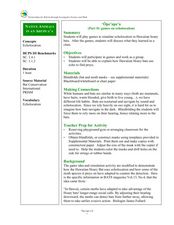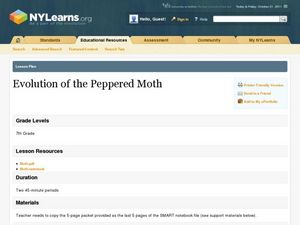Curated OER
Butterflies, Butterflies, Butterflies
Transform your class into a butterfly museum! Research different types of butterflies, their habitat, and life cycle. Interactive components such as PowerPoint presentations, Claymation movies, and webpages add pizzaz to the museum...
Curated OER
Games on Echolocation
Get a little batty with life science! This fun simulation game replicates how bats use echolocation to hunt moths in their native Hawaiian habitat. After creating blind folds and discussing some basic principles of echolocation, students...
University of Minnesota
Manduca sexta Wax Model
Caterpillars' and moths' most obvious change is physical, but what happens to their nervous systems as they complete metamorphosis? Through a hands-on investigation, young scholars construct the nervous system of a caterpillar. They then...
University of Minnesota
Manduca sexta: Caterpillar Dissection
Caterpillars have an amazing, yet tough job to perform in their short lives — eat much, avoid predators, and try not to let all those comments about being the unattractive stage of the life cycle get to them. How do they handle it all?...
CK-12 Foundation
Natural Selection: Peppered Moths
Can human activity influence the colors of moths? The simulation explains how pollution changed the color of tree bark, which led to the survival of a different variation of moths. It also discusses the shift back as air quality improves.
Roland Park Country School
Butterfly or Moth?
What is the main difference between a moth and a butterfly? Butterflies have club-shaped antennae, while moths have a feather-like antennae. But what else differentiates these beautiful insects? The presentation in the resource...
Curated OER
Moth or Butterfly
Students categorize butterflies and moths by identifying the unique characteristics of the two different species. In this classifying lesson, students discuss their prior knowledge about these insects before categorizing the...
Curated OER
Who am I?
Here is a colorful worksheet that has learners identify 16 different kinds of insects. Each insect has an accurate and colorful drawing associated with it. The insect names are at the bottom of the worksheet, and pupils must match up...
Curated OER
Butterflies
Butterflies and moths are the stars of this biology resource. In it, learners see how to distinguish a butterfly from a moth. They discover new vocabulary, perform an experiment, and do some coloring on pages that are embedded in the...
Alabama Learning Exchange
Is it a Moth or a Butterfly?
Second graders examine the similarities and differences between moths and butterflies. They participate in a virtual field trip using a designated web site. They design a computer based slideshow using the information they find on the...
Curated OER
Butterfly Round-Up
Students classify the characteristics of butterflies and moths moths. For this life cycle lesson, students identify butterflies and moths common in the state of Iowa as well as their characteristics. Students then learn the proper...
Curated OER
Moths and Butterflies crossword puzzle
In this moths and butterflies activity, students complete a crossword puzzle about moths and butterflies. Students complete 26 blanks in the crossword puzzle.
Curated OER
Butterfly and Moth Internet Hunt
In this butterflies and moths activity, students click on the links in the questions about butterflies and moths to find the answers to the questions and then come back and answer the questions. Students answer 14 questions total.
Curated OER
Main Idea and Supporting Details on Two Topics-Neeraj and Moths
Students explore details, supporting details, and main idea statements. In this details and ideas lesson, students view two video segments and determine relevant details. Students identify the main ideas and defend them.
Curated OER
Cloze Activity: Mini Worlds
In this butterflies, moths, and caterpillars cloze procedure worksheet, students review a brief selection that is missing 10 words and then attempt to fill in each blank with a word they think the author might have used. A word bank is...
Curated OER
Super Scientist Quiz
In this science worksheet, students match each of the descriptions on the right to the correct scientist listed on the right. There are thirty scientists to identify and match on the sheet.
Curated OER
Mazes
In this mazes worksheet, students figure out the best way to help a caterpillar on its journey to becoming a moth through a circle maze.
Curated OER
Butterfly or Moth?
Students compare and contrast the characteristics of the butterfly and the moth. Through classification, students observe the subtle differences in the moth and the butterfly. Students complete a worksheet classifying butterflies and...
Curated OER
A Moth Is Not a Butterfly!
Students identify the differences and similarities between a butterfly and a moth. They complete a Venn diagram, participate in class discussion and conduct related Internet research on the topic.
Curated OER
Life Cycle of a Butterfly/ Moth
Students explore the life cycle of butterflies, illustrate the life cycle of the butterfly, and compare the researched facts to stories written by Eric Carle about caterpillars and butterflies.
Curated OER
Evolution of the Peppered Moth
Seventh graders complete a timeline about the evolution of the peppered moth. In this biology lesson, 7th graders write an essay about how human can affect evolution. They share their essay with the class.
Curated OER
Going Buggy!
Students study bugs over a four week period. In this insect collection of activities, students observe insects covering basic science concepts and skills, such as classification, observation, and responses to habitat....
Curated OER
Mini Worlds
In this insects worksheet, students 18 questions regarding butterflies, moths, bees and spiders. A print out version of this worksheet is available, but the online version contains links to various webpages with information on the...
Curated OER
Adopt-An-Insect
In this biology worksheet, students locate examples of various types of insects listed in the chart and receive a point value for each according to its significance. Then they identify body parts and habitat for each item.

























